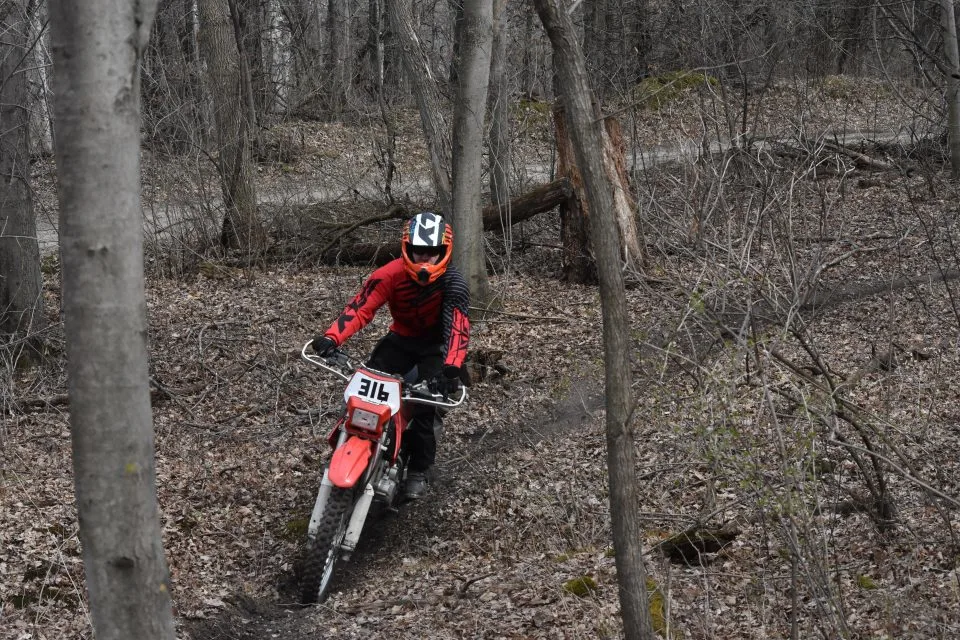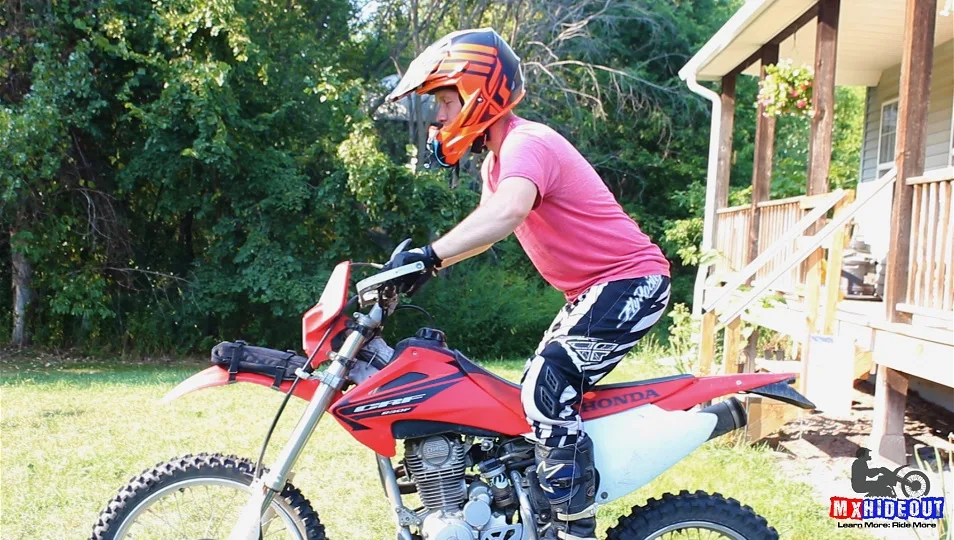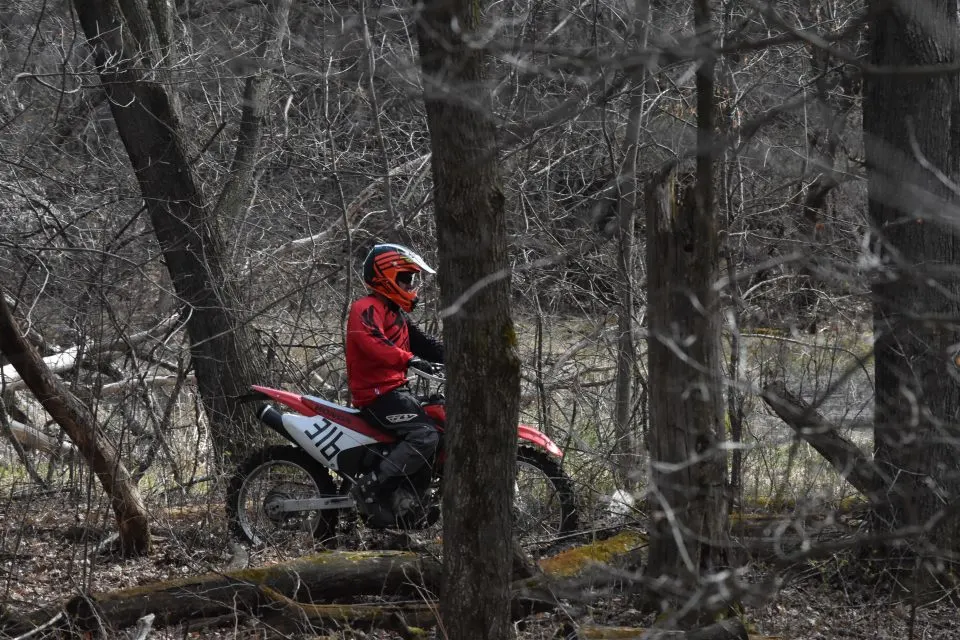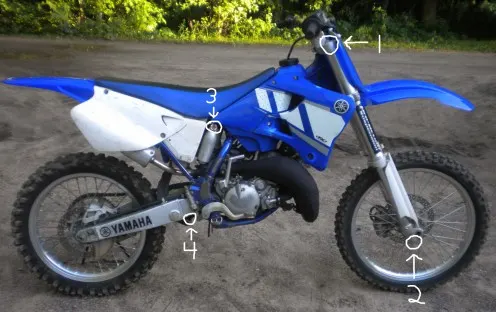Is your dirt bike suspension too stiff? Whether you’re not sure how to easily soften it, or you’re just intimidated by anything to do with suspension, you’ve found the right article!
In this post, I’ll show you how your suspension works, why it might be too stiff for you, and then a step-by-step tutorial on how to make it softer so that riding is more enjoyable and safer.
How dirt bike suspension works - a simple explanation
Your dirt bike suspension is simply a system to absorb (compression) as much impact from bumps, jumps and obstacles as possible while keeping the tires on the ground (rebound) as much as possible to give you traction.
If your tires aren’t touching the ground, then you have no traction. Not only will you not be able to accelerate to ride faster, but you can’t use the brakes to slow down - very dangerous at times!

So, a traditional set of forks use a spring that’s built for your weight and riding style to hold the bike up and prevent bottoming, and then there’s the valving and oil to control the damping of the forks - how quickly they compress and rebound.
Why your suspension is too stiff
There are two ways your forks can be too stiff: they won’t compress easily in the first ½ of the stroke (travel), or they sag too much and you’re riding at the bottom half of the suspension travel.
These are both common but very different problems, but we’ll focus on the first one because that’s the most typical issue.
The most likely reasons why your suspension is too stiff are:
- The forks and/or shock springs are too stiff (spring rate too high)
- The suspension is not balanced
- Too much pre-load
- The clickers need to be tuned for your type of riding
- The valving is too harsh
- Fork oil too high in forks
- Fork oil too heavy
What can happen if your shock or forks are too stiff?
It's going to be uncomfortable for one because you'll feel like all of the bumps are harsh. It's also dangerous and will slow down your confidence building.
When your forks are too stiff, your tires are more likely to "bounce" off bumps and obstacles. Once they leave the ground, you have virtually zero control. I'm not talking about when you ride over a jump, but rather those fractions of seconds here and there where you're not getting good traction.
We want to keep your tires on the ground so that you get the most traction, which will give you the most control. And when you have control, you have confidence and are able to ride faster and stay safer.
Getting your suspension balanced before anything else
There is a 2-step process to getting your dirt bike suspension balanced, depending on your current setup. You need to first make sure that your shock and fork springs are sprung for your weight.
Most stock dirt bikes have springs that are made for 150-180 pound riders, but it also depends on the type of riding you're doing and how aggressive you are. So, if you know your current spring rates are too stiff or too soft, get them replaced.
If you don't have the correct spring rates in your dirt bike, the suspension will never work as well as it could no matter how much tuning you do.
The second step to balancing your suspension is setting the sag or ride height. This is done by adjusting the rear shock sag with the external locking rings. More on this shortly.

How to make your dirt bike suspension softer
First, you need to figure out where in the stroke/suspension travel your dirt bike is too stiff. If you're not sure, have someone watch you ride where you normally do, or record yourself riding.
Pro Tip: to see how far your forks are compressing, put a zip tie on one leg near the top of the lower leg (or the bottom of the upper if it's an older conventional forks) and go ride. When you get back, you'll see how far down (or up) the zip tie is and you'll know how much suspension travel you're using. It should be near the limit for best performance.
To make your suspension softer, you must do at least one of the following...
Front forks too stiff
A rear shock that has the sag set too low will cause the rear end to be low and out of balance. This will make the front forks feel stiff and hard to get grip because it's harder to get weight over them. The rear shock will also feel soft from sagging low, to begin with.
Simply adjust the shock sag by loosening the top lock ring and turn the lower ring clockwise to increase the shock preload to make it stiffer.
Rear shock too stiff
When the rear shock is too high, it automatically puts more weight bias on the front. This makes the front end feel soft and mushy and the rear shock feels stiff and hard to get traction when accelerating.

The rear shock sag needs to be adjusted, so turn the lower ring counterclockwise to decrease the amount of sag and soften it.
After you have gotten the right fork springs and adjusted the sag, it's time to start working on the smaller things.
Adjusting the clickers
Most modern dirt bikes have "clickers" on the top and bottom of the forks and rear shock. These are tuning screws to externally and easily adjust the compression and rebound damping.

If you've never touched them before, you can try adjusting them 5 clicks at a time and then go ride to see if you feel a difference. Always do one change at a time so that you know which adjustment makes it feel better or worse.
If your dirt bike is older or just has conventional style forks and non-adjustable rear shock, you obviously can't externally do these adjustments. That's one disadvantage of having "simple" suspension components.
Fork Preload
Getting the shock preload is one of the first steps, but you can also add some preload to the front forks if you need them to "hold up" a little better in the travel.
You can do this with a PVC pipe that has the right size diameter to fit inside the fork legs. Adding a ½-1 inch long piece will make a difference in preload. I wouldn't recommend this if you're still a beginner in suspension tuning, but it's one possible way to fix a problem.
Oil weight
When your suspension compresses and rebounds, the oil inside gets pushed through small valves or holes. If the "weight" of the oil is lighter or thinner, it can move through these valves or holes quicker.
This will give you a softer feeling because the forks or shock can compress and rebound quicker. It's the "cheap man's" re-valve. It won't make a huge difference, but if you're looking for that last bit of plushness, a lightweight oil can help.
Oil height/air gap
Adjusting the oil height (AKA the air gap) can help make your dirt bike suspension softer a couple of different ways. Since air is easier to compress than oil, having a lower oil height increases the volume of air, making the forks slightly easier to compress when you hit a bump.
First, this also affects your sag, so the bike rides lower in the travel, but it also reduces bottoming resistance. Bottoming out the forks is not a good thing, but if your forks never get close to bottoming, giving up some resistance at the bottom can give you that extra inch or two of travel, which in turn gives you a softer feeling and better performing fork.
Removing 10-20cc of oil from each fork and testing is a good way to see if this little bit of tuning will help with your stiff forks.
Internal valving
Last, but certainly not least, is the internal valving, which I don't recommend you personally do unless you know what you're doing or have a suspension expert guiding you. Harsh or stiff suspension is often caused by the valving, even if you have the correct spring rates.
Tuning the valving can get quite complicated, especially with all of the different types of forks and shocks. You need a good selection of special tools to make working on them easy.
If you want the best performing and most comfortable suspension, tuning the internal valving might help.
The problem with sending out your suspension
With that said, I see too many people just automatically sending their forks and shock to the favorite tuner without even doing the basics or even knowing what they want.
You need to ride and test your bike so that you can tell your tuner what exactly you want improved. If you just say "I'm a 180 lb intermediate rider, make it better!" There's a good chance that it won't be perfect the first time you get it back. The tuner is simply guessing what needs to be changed because they haven't seen you ride.
How to ride with control on the trails
If you're a newer rider or struggling to advance your skills, I want to show you some quick ways to improve your confidence and control by using basic techniques. Click here to watch my free training workshop.


Donald
Saturday 8th of April 2023
I have a Chinese 250 k5 xtr highper . It has no clicker top or bottom. I set my sag to 105 mm and it’s dangerously stiff in the back. I guess I just need to loosen the spring until it feels comfortable.?
Kelley Fager
Monday 10th of April 2023
Hey Donald, you can loosen it more, but it may cause the suspension to be unbalanced (too low in the rear) and the front end may have less traction. It may be due to the internal damping being too slow. I'm not familiar with that specific shock, but if there are no other external adjustments then you may need to upgrade to a better shock or send it to a professional tuner that knows how to make it better if you want to feel a significant improvement.